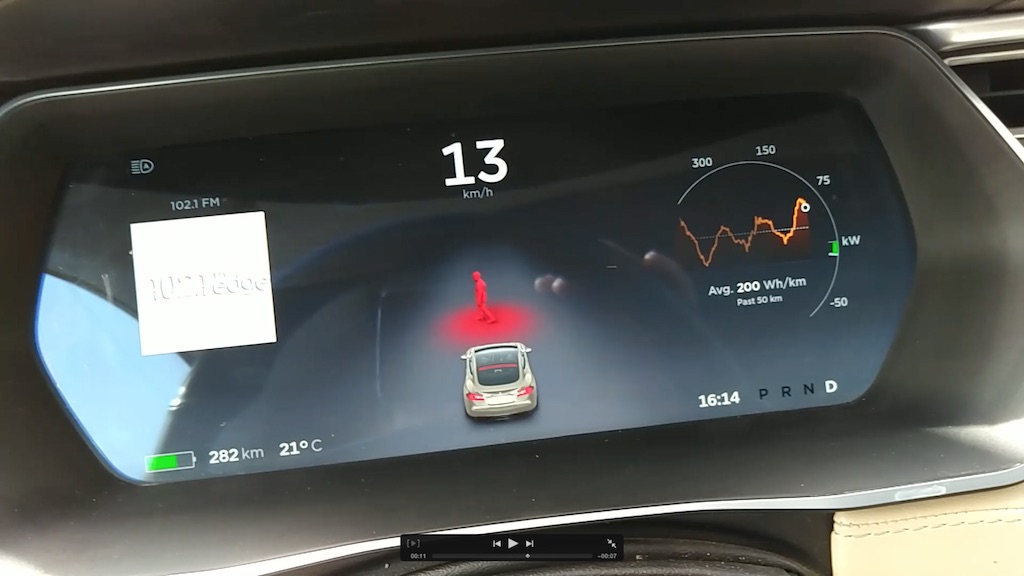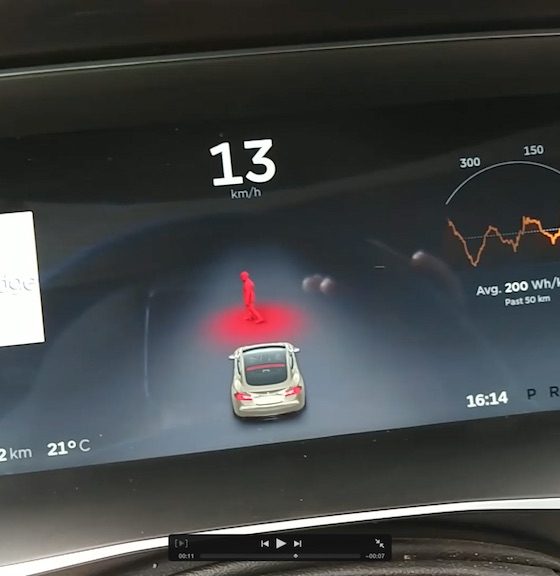

News
Tesla Model S owner reminds us of ‘Active Hood’ pedestrian safety feature
A relatively unknown Tesla safety feature called ‘Active Hood’, designed to reduce head injuries to pedestrians in the event of a frontal collision, was brought to light in a recent Model S owner’s video that attempts to capture Tesla’s Automatic Emergency Braking (AEB) in action. Active Hood which exists on European and Australian Model S vehicles uses pyrotechnics to raise the rear of the hood by several inches in order to soften the impact of a pedestrian and cyclist against a windshield during frontal impact.
Model S owner and Tesla Motors Club forum member Carspotter Daily posted a video that attempts to simulate a vehicle-pedestrian interaction. The vehicle was a first generation Autopilot vehicle under Firmware 8.0. It’s unclear whether CarSpotter was intentionally trying to trigger Tesla’s Active Hood feature or whether they were looking to test the AEB system, but despite not being able to trigger either feature the end result revealed, once again, Autopilot’s ability to detect humans. Another Tesla owner YouTuber KmanAuto first detected the pedestrian alert last November when he put a friend in front of of his moving Model S.
This type of granular detection of objects allows the vehicle to respond to potential collisions in the most appropriate way, with the objective to reduce collisions entirely. Though Active Hood was mentioned in the trailing notes at the end of the recent video, it’s not clear if the vehicle used in the video is a U.S. spec Model S or a European/Australian version that was included with that safety feature.
ALSO SEE: DIY Tesla Model S Pedestrian Alert: ‘Horn’ for the Oblivious
Active Hood is not a new feature but the fact that it has only been implemented on Tesla vehicles in select markets that mandate the technology has kept it largely under the radar. The technology was built into Tesla vehicles to comply with Euro NCAP Pedestrian Safety requirements that mandate vehicle manufacturers to maintain clearances between the hood and structural components underneath, to protect pedestrians in the event of a low to medium speed collision. These accidents often prove fatal to the pedestrian, as collisions at low to medium speeds typically cause the pedestrian’s body to fold over the hood with the head hitting the windshield.
The system was put to use in real world conditions in Australia in 2015 when someone driving a Tesla Model S collided with a kangaroo which caused the system to deploy. From what they saw after the accident, it looked like the adolescent ‘roo had a broken leg but was conscious enough after the accident to limp away which seems to indicate that it was successful in preventing immediate head trauma.
Tesla had a special challenge when designing Active Hood since the front trunk of a Model S is sealed to keep water out whereas hoods to internal combustion engine vehicles are generally vented. US Patent Application US20130076076 A1 details the specific challenges and solutions developed to allow the hood to pop up in response to an imminent collision with a pedestrian.
The English European version of the Tesla Model S manual lays out the technology in a much more user friendly format:
Active Hood
With Active Hood technology only existing on vehicles destined for the European and Australian markets, and Tesla being so aggressive about implementing safety features, the natural question is “why hasn’t Tesla made this a standard global safety feature?” An early Euro NCAP crash test video showed that Tesla began working hard at doing everything it can to avoid the accident in the first place. After all, avoiding a collision in the first place is far better for all parties involved than just mitigating what happens afterwards.
News
Tesla Sentry Mode helps lock up drive-by shooting suspect in Seattle
“A nearby Tesla actually captured the video that showed a man crouched behind a vehicle firing gunshots. A lot of vehicles record, and officers know that Teslas, especially, record, so we use that video all the time in these instances.”

Police in Seattle, Washington, are crediting Tesla’s well-known Sentry Mode for helping find a suspect in a drive-by shooting case.
A 21-year-old was arrested for an alleged drive-by shooting in the Pioneer Square neighborhood of Seattle this past Sunday, and the leads on the case seemed to be slim.
However, a Tesla parked nearby was able to record the shooting, as well as the car that the suspect hopped in after the crime occurred. It helped police identify the person they were looking for.
Seattle Police Department Detective Brian Pritchard said to MyNorthwest that the Tesla was a critical part of finding the suspect and placing him under arrest:
“A nearby Tesla actually captured the video that showed a man crouched behind a vehicle firing gunshots. A lot of vehicles record, and officers know that Teslas, especially, record, so we use that video all the time in these instances.”
The Tesla footage helped the Police put the suspect into handcuffs about an hour after the crime was committed. They are currently charged with drive-by shooting and unlawful possession of a firearm.
Tesla Sentry Mode is a security feature the vehicle utilizes to help solve crimes like vandalism, but it is also a cool feature that has caught things like accidents and other incidents on camera.
Many people still do not know about it, including the many vandals who keyed or broke the windows of Teslas earlier this year, as people damaged others’ cars in an act of retaliation against CEO Elon Musk when he became involved in politics.
This is far from the first time Sentry Mode has helped Police Departments solve crimes. Last September, we reported on Oakland’s Police Department in California using Teslas near crime scenes to help solve cases.
Tesla Sentry Mode is Oakland PD’s secret weapon against rising crime
Sergeant Ben Therriault, president of the Richmond Police Officers Association, said, “We have all these mobile video devices floating around,” in reference to the Teslas that sit and capture nearly everything that surrounds them.
Sentry Mode has helped officers arrest a variety of suspects, including several people who were allegedly involved in the murder of a 27-year-old woman in Northern California.
Elon Musk
Tesla investors are ditching Charles Schwab after its vote against Musk comp plan

Tesla investors are ditching Charles Schwab as their brokerage after the firm said earlier this week that it would vote against CEO Elon Musk’s new compensation package.
Several high-profile Tesla influencers are speaking out against Charles Schwab, saying its decision to vote against the plan that would retain Musk as CEO and give him potentially more voting power if he can achieve the tranches set by the company’s Board of Directors.
The Tesla community recognized that Schwab is one firm that tends to vote against Musk’s compensation plans, as they also voted against the CEO’s 2018 pay package, which was passed by shareholders but then denied by a Delaware Chancery Court.
Schwab’s move was recognized by investors within the Tesla community and now they are speaking out about it:
Hey @CharlesSchwab – I need to speak with someone from Schwab Private Wealth Services this week. Please reach out via email, the mobile app message center, phone, or X DM.
Here’s why this is urgent: At least 6 of your ETF funds (around 7 million $TSLA shares) voted against… https://t.co/uSgPWnfTFc
— Jason DeBolt ⚡️ (@jasondebolt) November 3, 2025
If @CharlesSchwab doesn’t vote for Elon Musk’s 2025 CEO Performance Award plan, I’ll move all my assets to another brokerage. My followers, many of whom also hold assets with Schwab and collectively own at least hundreds of millions in $TSLA, may do the same.
I can’t in good… https://t.co/6iUU6PdzYx
— Sawyer Merritt (@SawyerMerritt) November 3, 2025
ready to help with the @CharlesSchwab exodus
— Gali (@Gfilche) November 3, 2025
At least six of Charles Schwab’s ETFs have voted against Tesla’s Board recommendation to support the compensation plan for Musk. The six ETFs represent around 7 million Tesla $TSLA shares.
Jason DeBolt, an all-in Tesla shareholder, summarized the firm’s decision really well:
“As a custodian of ETF shares, your fiduciary duty is to vote in shareholders’ best interests. For a board that has delivered extraordinary returns, voting against their recommendations doesn’t align with retail investors, Tesla employees, or the leadership we invested to support. If Schwab’s proxy voting policies don’t reflect shareholder interests, my followers and I will move our collective tens of millions in $TSLA shares (or possibly hundreds of millions) to a broker that does, via account transfer as soon as this week.”
Tesla shareholders will vote on Musk’s pay package on Thursday at the Annual Shareholders Meeting in Austin, Texas.
It seems more likely than not that it will pass, but investors have made it clear they want a decisive victory, as it could clear the path for any issues with shareholder lawsuits in the future, as it did with Musk’s past pay package.
News
Tesla Cybertruck explosion probe ends with federal involvement and new questions
The 78-page document detailed a planned attack by former Green Beret Matthew Livelsberger, who died by suicide before the blast that injured six people.

The Las Vegas Metropolitan Police Department (LVMPD) has released its final investigative report into the New Year’s Day Cybertruck explosion outside the Trump International Hotel. But instead of bringing clarity, the findings have only raised more questions.
The 78-page document detailed a planned attack by former Green Beret Matthew Livelsberger, who died by suicide before the blast that injured six people.
The perpetrator’s manifesto
According to a Fox News report, Livelsberger rented the all-electric pickup through Turo while on leave from his Special Forces unit. He filled the rented Cybertruck with fireworks, gas cans, and camping fuel before driving it to the hotel shortly after 8:40 a.m. on January 1. Surveillance footage showed him pouring accelerant into the truck bed moments before detonation, confirming premeditation.
Livelsberger left a manifesto on his phone, which was later deemed classified by the Department of War. This case was then handed over to federal authorities. Still, the LVMPD and federal investigators noted in their report that the incident was a “vehicle-borne improvised explosive device” (VBIED) attack “with the potential to cause mass casualties and extensive structural damage.” Officials, however, stopped short of labeling it terrorism.
In digital notes, Livelsberger wrote that his act was not terror-related but intended as “a wake-up call,” criticizing what he called America’s “feckless leadership.” He wrote, “Americans only pay attention to spectacles and violence. What better way to get my point across than a stunt with fireworks and explosives.”
The incident ironically showcased the Cybertruck’s durability
Tesla CEO Elon Musk was among the first to respond publicly after the blast, confirming through X that the company’s senior team was investigating the incident. He later stated that vehicle telemetry showed no malfunction and that the explosion was caused by “very large fireworks and/or a bomb” placed in the Cybertruck’s bed.
Ironically, footage of the incident in the Cybertruck’s bed showed that the vehicle’s durable construction actually helped contain the explosion by directing the blast upwards. The bed remained largely intact after the explosion as well. Even more surprisingly, the Cybertruck’s battery did not catch fire despite the blast.
Months later, the same Cybertruck appeared on the online auction platform IAA, marked as “not ready for sale.” The listing has stirred debate among Tesla fans about why the historic vehicle wasn’t reclaimed by the company. The vehicle, after all, could serve as a symbol of the Cybertruck’s resilience, even in extreme circumstances.
-

 News2 weeks ago
News2 weeks agoTesla rolled out a new feature with FSD v14 to fix a major complaint
-

 News2 weeks ago
News2 weeks agoTesla just made Service even easier and more convenient
-

 News2 weeks ago
News2 weeks agoTesla Full Self-Driving’s new version officially gets a wider rollout
-

 News2 weeks ago
News2 weeks agoTesla makes crazy move to spur short-term demand in the U.S.
-

 News2 weeks ago
News2 weeks agoTesla Sweden faced with fresh strike from elevator company
-

 News2 weeks ago
News2 weeks agoKia and Tesla top list in Swedish study of strongest EV batteries
-

 News2 weeks ago
News2 weeks agoTesla is looking to conduct FSD tests in new Swedish city: report
-

 Investor's Corner2 weeks ago
Investor's Corner2 weeks agoTesla analyst says this common earnings narrative is losing importance

















